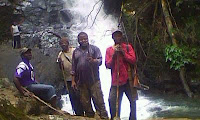The Bunoh village is one of the five small villages that make up the Nchum Village Community in the Bafut Subdivision of the North West Region of Cameroon. Bunoh will hence have its place on the map after a research team from the Organization For Life Care (OFLIC) visited the village for a baseline study. The team was there to commence preliminary studies that could transform the village into a conservation and ecotourism boiling pot.
Arriving Bunoh, the team headed by OFLIC’s Executive Projects Director made contact with the community members and its leaders during a briefing session. During the session, the objective of the visit was clearly explained as well as its expected outcome and importance to the community as a whole. The impotence of the community contributing and actively participating in the project was equally explained. At the end of the session, their representatives were selected to join the research team to commence a two days field work that let them to visit the remnant of virgin forest within the community that has served as a sacred forest and its environs.
The laborious field visits took the team through very rough terrain, down steep slopes, across farmlands up steep slopes and along winding streams. In all, the team documented the rich biodiversity content of the demarcated region, wonderful touristic attractions including sacred shrines, magnificent waterfalls and pools.
On a global scale, it was resolved that the location needed an urgent conservation program to safe it from the pressures mounted on it by the community members. A huge chunk of the forest has been cut down for agricultural purposes and for the wood. The once huge population of great apes and other animal and bird species in the forest has been hunted down to near extinction and what is left of it is being chased out of its natural habitat.
The effects of climate change are evident within the forest as the consequence of deforestation has caused many of the streams to dry off.
Conclusively, the OFLIC team agreed with the community members to establish an integrated conservation program for the forest and its biodiversity that will integrate components of biodiversity reintroduction (especially the great apes including gorillas), ecotourism and agroforestry.
The demarcated area covers some 100 hectares that will hence serve as a community protected area. A team was setup to establish all community members who own pieces of land within the demarcated area so they can be reimbursed.
OFLIC is currently in the process of elaborating a project, contacting potential partners and fundraising for the project.
We use this forum to invite interested organizations and individuals to support us on this lofty and burdensome journey.



No comments:
Post a Comment